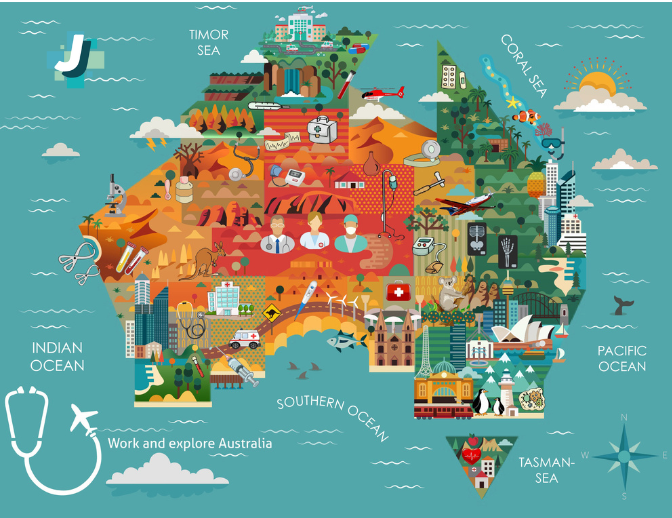Doctor registration in Australia: Your provisional AHPRA checklist
Embarking on a medical career in Australia involves navigating the registration process with the Australian Health Practitioner Regulation Agency (AHPRA). To streamline your provisional registration journey, Jon and Jon Medical Recruitment have created this resource:
The growing presence of overseas doctors in Australia
Australia's healthcare system has always benefited from the contributions of internationally qualified practitioners. In recent years, this trend has accelerated significantly. In fact, the number of overseas-trained doctors registering to work in Australia nearly doubled in 2023, highlighting the increasing reliance on international talent to meet the country's healthcare needs.
The statistics speak for themselves:
- Over 56,000 new international practitioners registered in Australia between January 2022 and July 2024.
- Medicine represents a significant portion of these registrations, with over 11,800 doctors joining the workforce.
This influx of overseas doctors is a testament to Australia's appeal as a destination for medical professionals seeking new opportunities and a high quality of life. It also underscores the vital role that international practitioners play in ensuring access to healthcare for all Australians.
At Jon & Jon, we're proud to support overseas doctors in their journey to practice in Australia once registered with AHPRA. We understand the unique challenges you face and are committed to providing guidance and assistance every step of the way.
If you're an overseas doctor that has recently completed and successfully acquired your AHPRA number, then feel free to reach out to us for more information on roles that might be suitable for you. Rather than scouring job boards only to find the position is no longer available, we can work with registered doctors in making dreams come true to work in Australia.
Document certification for overseas doctors
We understand that navigating the AHPRA registration process from overseas can be challenging. Let's clarify how to obtain certified copies of your documents while abroad:
What is a certified copy?
A certified copy is a photocopy of an original document that has been verified as a true copy by an authorised person. This verification process ensures the authenticity and accuracy of the submitted documents.
Certification process:
- In-person certification: It's essential to have your documents certified in person. Virtual certification over video calls is not accepted.
- Instructions: Download our helpful PDF guide, "Certifying Documents Instructions," to take with you when you meet an authorised officer for certification.
Specific requirements:
- Documents without a photograph:
- The certifier must write a specific statement on the copy: "I have sighted the original document and certify this to be a true copy of the original."
- They also need to include the date, their name, contact phone number, occupation/profession (with registration number, if applicable), and their stamp or seal (if relevant).
- Documents with a photograph:
- The certifier must write a slightly different statement: "I certify that this is a true copy of the original and the photograph is a true likeness of the person presenting the document as sighted by me."
- The additional requirements are the same as for documents without a photograph.
- Multi-page documents:
- Each page needs to be initialled and numbered by the authorised officer, in addition to the certification statement on the first page.
Who can certify your documents overseas?
- Notary public: This is a common and widely accepted option for certifying documents for international use.
- Australian embassy/consulate staff: Contact your nearest Australian embassy or consulate to enquire about their certification services.
- Employee of the Commonwealth or Australian Trade Commission: If you have access to such an individual, they can also certify your documents.
- Justice of the Peace: Some countries have Justices of the Peace who are authorised to certify documents.
Important Notes:
- Identity certificate: If your documents are certified by an Australian Consular Officer or Australian Diplomatic Officer and include a photograph, they must also issue an Identity Certificate, which should be submitted along with your application.
- Additional Information: For detailed information on certification requirements and a complete list of authorised certifiers, refer to the AHPRA website.
Who can certify your documents overseas?
- Notary public: This is a common and widely accepted option for certifying documents for international use.
- Australian embassy/ consulate staff: Contact your nearest Australian embassy or consulate to enquire about their certification services.
- Employee of the Commonwealth or Australian Trade Commission: If you have access to such an individual, they can also certify your documents.
- Justice of the Peace: Some countries have Justices of the Peace who are authorised to certify documents.
Important notes:
- Identity certificate: If your documents are certified by an Australian Consular Officer or Australian Diplomatic Officer and include a photograph, they must also issue an Identity Certificate, which should be submitted along with your application.
- Additional information: For detailed information on certification requirements and a complete list of authorised certifiers, refer to the AHPRA website.
Checklist to gain to register to work in Australia for overseas doctors
1. Certified copy of passport:
- Submit a certified copy of your passport's photo page.
- If your passport is not in English, include a certified translation.
2. Two additional certified documents:
- Choose two from the following:
- Current Australian visa (along with your overseas passport)
- Full birth certificate
- Driver's licence with photo and signature
- Full marriage certificate
- Government-issued identity card with photo and signature
3. Certification requirements:
- Ensure the certification statement on photo documents confirms the copy's authenticity and the likeness of the person pictured.
- For non-photo documents, the statement should certify it as a true copy of the original.
- The certifier must include their signature, name, occupation (with registration number), stamp/seal (if applicable), phone number, and date.
4. Primary medical degree certificate:
- Submit a certified copy of your original medical degree certificate.
5. Internship documentation:
- Provide a certified copy of your internship certificate or an official letter confirming its completion.
6. Certificates of good standing:
- If you're registered outside Australia, ask your medical board to send your Certificates of Registration Status or Good Standing directly to AHPRA at COGS@ahpra.gov.au.
7. Criminal history check:
- Submit the reference page from your International Criminal History Check (ICHC). Apply through the AHPRA website.
8. English language test results:
- If you've taken an English language test within the past two years, provide a copy of your results, including reference numbers, for AHPRA verification.
9. Employment & supervision:
- Include your letter of offer, position description, APRI-30 (Agreement for Provisional Registration for International Medical Graduates), and SPPA-30 (Supervision Plan for Provisional Registration for International Medical Graduates).
10. Submit your application:
- Once you have all your documents ready, submit your application through the AHPRA online portal.
Remember:
- Double-check that all documents adhere to AHPRA's certification standards to avoid delays.
- For detailed information and guidance, refer to the AHPRA website:https://www.ahpra.gov.au/.
- Jon & Jon Medical is ready to assist you in finding the perfect locum or permanent position once you're registered.
Important Note: This checklist is a simplified guide. AHPRA requirements can change, so always consult their official website for the latest information.
Join Our Wide Network Of Doctors All Over Australia

Blog form
Check out what our clients and doctors say about us on google











